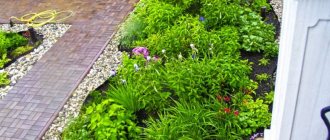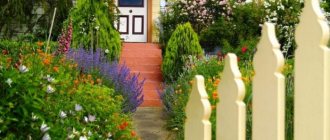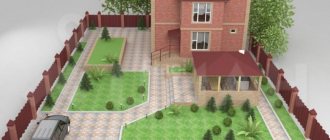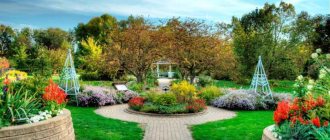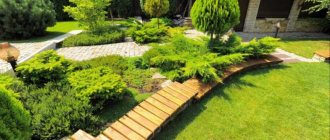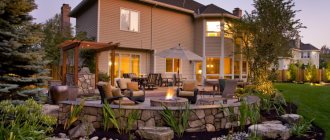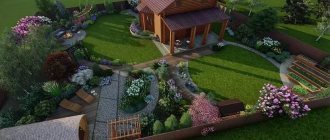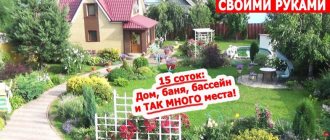A plot of 15 acres is quite a large area. The more land, the more difficult and expensive its design becomes. Owners of such plots have the opportunity to place a residential building, bathhouse, garage, swimming pool and other buildings on them. There is also enough space for a garden for relaxation and outbuildings. All that remains is to place it all correctly.
Professional land planning
Purchasing a summer house
Before constructing a residential building and utility structures, geologists study the properties of the area, to which the project of a 15-acre plot is later linked. Among them, the following nuances are of greatest importance.
The height of the dacha land. Atmospheric precipitation accumulates in the lowlands, negatively affecting the integrity of structures. Implementing artificial bedding using modern technologies takes a fairly significant amount of money, but is practically impossible to improve the situation. Therefore, sites are traditionally selected at higher elevations, which reduces the cost of construction work and reduces the speed of destructive processes.
The depth of underground aquifers directly controls the complexity of arranging an autonomous water supply by digging an artesian well, as well as the bearing capacity of the soil.
- Presence of trees. Here, excess vegetation is cut down, and the remaining stumps are eliminated by uprooting. The necessary buildings can be placed on the vacated territory.
- The depth of freezing of the ground controls the size of the hole dug before constructing the foundation.
- Height differences throughout the entire area. If significant changes are detected, you will need to level the ground yourself, or create a horizontal pile-type foundation.
- The presence of a reservoir in a lowland indicates that the groundwater level is too high and possible flooding of the ground in the spring.
- The type of soil determines the difficulty of performing the work. For example, the presence of rock, clay or peat will increase the complexity of construction operations.
- The width and length of the territory controls the geometric shape of structures intended for housing and farming.
- The proximity of a centralized electrical network makes it possible to inexpensively supply electricity to the house.
- Placing the dacha relative to the prevailing winds will help control year-round illumination, the heat-saving properties of the home, the well-being of garden plants, and the mood of the owners.
Basic planning rules
To draw up a project for a site, they turn to special organizations that do this professionally, but their services cost a lot of money. The range of prices is huge and starts at 100 thousand rubles.
Such a high cost is due to the fact that the project includes drawings of all buildings, calculations of their strength, detailing, compliance of the foundation with the soil, the position of the buildings relative to the wind rose, and so on. This work is serious and without being a technically savvy and educated specialist, it will not be possible to complete it.
However, not everyone can afford such costs, which is why only a “graphical shell” is ordered - the customer wants to see only the locations of objects, including plants. He undertakes construction without a project, or orders it only for the main buildings (the project and sectional drawing of the house are presented in the article).
The approach saves money, but can lead to serious losses of money during the construction phase. It’s not for nothing that they say that “the miser pays twice.”
If projects have not been ordered, it makes sense to independently distribute objects across the site. To do this, you need to take into account and observe several points:
- The terrain of the site. Depending on the level of differences, locations for some objects may already be suggested. The ground level also determines the optimal location of communication lines. Non-pressure sewerage, in which wastewater moves by gravity, depends most on this factor.
The photo shows an example of an area with a sharp change in relief
- Shape of the site. A plot of land can be square, rectangular, irregular in shape, narrow, wide - all this affects the arrangement and distribution of objects along it. The shape of buildings also largely depends on this. The more complex the geometric shape of the site, the more difficult it is to distribute objects on it.
Area of complex geometric shape
- Soil type. Soil composition is of utmost importance before any construction begins. The type of foundation of the house, the method of installing an autonomous sewage system, and the order of planting plants will depend on this (at what distance from the house to plant trees, read the article), since they may not develop equally well on all soils.
Test drilling to study the composition of the soil is a mandatory step before building a house
- The presence of natural reservoirs on the site and checking the groundwater level (GWL). The reservoir will largely determine the location of buildings on the site. There are sanitary regulations that define the distances at which residential and technical buildings must be separated from a natural body of water. They are trying to build recreation areas in close proximity to the ponds. The groundwater level will show the type of foundation, methods of waterproofing the basement, the need for backfill and other important technical parameters. Flooding of houses is one of the most common problems of structures built without a design.
The higher the groundwater, the more expensive and complex the construction
Planning
After completing all the stages of correctly selecting a suitable territory, the labor-intensive planning of a plot of 15 acres begins. It involves the formation of professional drawings with diagrams of objects and predetermined parameters of the distance between them.
When creating a layout, design experts determine the optimal configuration of the main ones, as well as the possibility of adding future structures. This work is accompanied by a search for a place for a residential building, traditionally located on the north side.
The design of the veranda will gain operational comfort and excellent appearance if it is placed on the south side. The following steps propose to create a garden area with a corner of real wildlife.
In an orderly zone of green spaces, an effective plant watering system is assembled, attractive paths are constructed from natural materials, and the site is landscaped. When creating a recreation area, structures for a swimming pool, as well as barbecue and game areas are installed.
Quite comfortable gazebos, artificial ponds and beautiful benches are an excellent addition. A comfortable relaxation zone is traditionally created at the end of construction work, which in the process of space planning greatly simplifies the determination of the location and types of objects being constructed.
Household block
The economic zone includes buildings used for storing things, conducting various activities, and other things. The previously mentioned garage also falls into this category. The buildings in this zone have not been located. They can be located in different parts of the plot, being not connected with each other, so the economic part is called a zone conventionally.
Outbuilding made of composite materials
The following buildings are classified as outbuildings:
- Shed - a place is determined for it either in the corner of the site, or it is attached directly to the house if it needs to be used often.
- Workshop - the place for it is determined according to the type of activity. If the owner does something professionally, he will need the ability to easily import materials. In such cases, the house is moved deeper into the lot, leaving more space for the front yard. A workshop, like a garage, can be installed on the border of the site to create a separate entrance.
- Garage - depending on the wishes of the developer, it is carried out in the form of a separate building or attached to a residential building. The second option is convenient because you can immediately get inside from the garage, but the noise of a car in the house causes inconvenience to many people.
The garage is combined with the house
- Sanitary facilities can also be included here - an outdoor toilet, an outdoor shower and a bathhouse, although the latter can also be considered a place for relaxation. The least number of questions will arise with the position of these structures - they are removed to the backyard, deep into the site.
Regular
The greatest simplicity is achieved by regular site planning schemes that maintain symmetry and maximum accuracy of the lines formed. This method is chosen by people who are not rich enough, who are unable to fully pay for the services of an experienced designer, and who are also afraid of making many irreparable mistakes in the process of arranging structures.
According to its rules, all objects for economic, garden and residential purposes are placed symmetrically relative to the selected axis.
Georeferencing
Before distributing the territory, it would be a good idea to study the composition of the soil and the depth of groundwater. Where the water lies close to the surface, they dig a well, and choose the driest place for the house.
Green plantings are placed on the richest soils possible. The sunniest places are reserved for them.
Landscape
Summer residents who order it receive the freedom to choose structures that are usually present on an uneven landscape with irregular geometry. The inconvenience caused by elevation changes and incorrect form disappears after the construction of artificial slides, as well as winding paths.
This style involves an illusory chaotic arrangement of objects and the absence of symmetrical lines. To create a spectacular appearance, all elements of alpine slides, compact ponds, natural decor and forged structures are carefully thought out.
Standard design
The main thing in this layout is the residential building, which is usually located in the center of the territory. All other buildings and green areas that the owners want to place surround the house from different sides. This layout is ideal for square or rectangular plots of land.
By thinking through everything to the smallest detail at the planning stage, you will not need to waste time on finalizing the project after its implementation Source co.pinterest.com
Often, with such an organization of the site, setting up a vegetable garden is not provided. Instead of vegetable beds, flower beds are laid out, ornamental shrubs are planted, border plantings are arranged along paths, etc. Garden decorative sculptures should not be excluded from the project: they not only decorate the site, but also create its relief, focusing attention on the transitions from one zone to another.
Facilities zone
The best side for the construction of a residential building and other structures for economic purposes is the north. This arrangement will improve the visibility of the garden, vegetable garden and recreation area. Through the window openings of the bedroom and living room located on the north side, too little light radiation will penetrate, which will worsen the mood of the owners.
If people do not like to see open space and contemplate too high fences, they are recommended to grow grape or blackberry hedge bushes.
Garage
A place for a garage or open parking should be located near the road, which is logical, and away from the habitat of children, guests and residents of the house, who do not at all need the sounds of a starting engine and not the most pleasant smells.
Note!
Flowers for a flower bed - 140 photos of the most beautiful and unpretentious flower options for a summer cottage
Do-it-yourself flowerbeds - instructions on how to make a beautiful and cozy flowerbed in your summer cottage (120 photos of new ideas)
Fast-growing climbing plants for the fence and garden - a review of the best types (120 photos). Instructions: how to select and plant climbing plants
Garden
When trees are planted around a home, it is necessary to take into account their future growth and the formation of shade in which the living quarters will end up. Before planning a plot of suburban territory, the design of the irrigation system is designed and the sides of the plantings are selected.
For example, for the full development of currants, shade is necessary, and most other types of flora consume natural light radiation. To facilitate access to garden structures, paths are constructed from natural materials.
The modern vegetable garden has become an element that harmonizes perfectly with the overall style, looking like small neat beds with vegetables and edible herbs. When forming it, it is planned to have perennial or annual crops. If you plant special companion plants, you can create attractive floral compositions from compatible species. The advantages of annual seedlings allow you to change the appearance of your garden and flower beds every year.
New Year in the yard: how to beautifully decorate the yard with your own hands!- How to make a modern landscape design with your own hands?
Microgreens at home
Useful tips
In the process of landscaping the site, you should follow the advice of experts:
- sea buckthorn grows quickly;
- hazelnuts need a large area and periodic pruning;
- plum is susceptible to fungi and pests;
- walnut grows strongly and provides shade;
- Cherries do not tolerate moisture well;
- In order for the pear to bear fruit well, it is necessary to plant several trees.
Relaxation area
When drawing up a plan for a recreation area, it is recommended to consider a photo of a plot of 15 acres. A person with the appropriate skills and knowledge will quickly get excellent results.
If the owner has enough funds, it is recommended that he order the services of a company specializing in the design of recreation areas. For children, you can build a compact playground with a sandbox, swings and horizontal bars. For adults, a gazebo, a swimming pool and a barbecue area are quite suitable.
House
The main building most often becomes the center from which all other zones of the site are built. Since 15 acres is a fairly large area, the house can be placed in the center of the site, away from roads with their dust, exhaust fumes, and noise.
The façade of the house faces the driveway or entrance path, and they try to make most of the windows facing the garden. If the central part of the building faces south, then the area around the house will always be sunny and comfortable. Typically, about 10% of the area is allocated to residential buildings.
Lighting
Street lighting devices are usually classified into two types:
- Upper. Represented by lanterns and spotlights. The former can be battery-powered or electric. Solar-powered lanterns charge during the day and provide light at night. For electrical appliances you will have to run wiring.
- Lower ones. This type of lighting typically uses LED strip lights or tiny decorative bulbs.
Also, individual figures or compositions can be illuminated on the site solely for beauty.
We carry out territory planning
Drawing up a site plan is a surefire way to quickly and correctly position objects. You can manually draw a schematic diagram of the proposed arrangement, respecting the scale of the components.
After completing the sketch, analyze the situation. It is important to consider:
- location of cardinal directions;
- presence of water sources;
- relief of the territory.
After this, the correct arrangement of objects is made. Be sure to follow the logic of combination.
Purposeful choice
Adherents of a certain design style are better off not deviating from the intended scheme.
There are many options, among which you can really choose the most suitable model. Some people like the strict English style. Some do not change Slavic traditions.
It’s not difficult to beautifully decorate a plot of 15 acres. The spacious area will allow you to conveniently place all the necessary objects. Imagination in design development is also not very limited.
Landscaping of the site
First, you need to choose the right time to carry out work on arranging your summer cottage. Decorating the garden at the initial stage will greatly disfigure the area, so it is best to do it in the fall or spring. The period of withering on the eve of winter is preferable, since in six months, freshly planted trees and shrubs will have time to take root and gain strength, and in warmer times the area will already have time to turn green. Arranging a garden is also best done in the fall. This is especially convenient if you plan to place greenhouses and raised beds. Planting vegetables in the spring will already take too much time. This process will be easier if part of the task is completed first.
Landscaping a site begins with identifying the main factors influencing plant growth:
- Climatic conditions;
- Soil type;
- Relief.
Not everything that grows well in the south will take root in the central part of Russia. Due to the peculiarities of the relief, certain plants can bloom and smell even among neighbors, but wither in their own flowerbed. Landscaping is carried out in several directions at once. According to the classical principle of division, plants are classified into three groups:
- External, that is, a hedge that is visible to the entire street.
- Internal. This includes those plantings that are directly adjacent to a country house.
- Intermediate. Any plants located on the site and performing a decorative function.
Plantings can also be classified into the following types:
- Trees and shrubs. As a rule, perennial plantings that will last for many years.
- Flower beds and flower beds. Exclusively ornamental plants, on which the aesthetic appearance of the territory largely depends.
- Lawn. A grassy surface that will occupy most of the “unowned” area.
- Beds. Although they belong to gardening, some plants that are useful in cooking look great and can become part of the decor.
Now let's talk about each type in more detail.
Lawn
The lawn is necessary to camouflage the “bare earth”. After all, the dacha plot is located in nature and it is wrong to pave most of the territory, since the surface will invariably remind you of an urban concrete jungle. There are four main types of lawn:
- Parkovy. The most common type. Its grass grows slowly, which greatly simplifies its care. The park lawn seems to have been created for walking barefoot. It is soft, elastic and gives the area a certain nobility and sophistication. The composition of park lawn grasses usually includes: oak grass, meadow timothy, perennial ryegrass and common comb grass.
- Parterre. They decorate the home areas of rich estates and elite cottages. The ground lawn requires regular maintenance: mowing, watering three times a month, and fertilizing. It is based on several types of fescue - grasses with narrow leaves.
- Mauritanian. Perhaps the most colorful type of lawn. The herbs include cornflowers, forget-me-nots, calendula, string, delphiniums, chamomiles, daisies, poppies, pansies, thyme, forget-me-nots and about 30 other types of wildflowers. Forbs require almost no maintenance: they only need to be trimmed once a year. But during the flowering period, the Moorish fragrant “carpet” will gather a buzzing armada of bees and battalions of butterflies, gracefully fluttering from flower to flower.
- Rolled. A lawn is suitable for those who don't want to wait for the grass to grow. It is grown in special fields for two years, then trimmed, cut off along with the roots and top layer of soil and rolled into rolls. The buyer can only roll them out on his site and compact them.
Any type of lawn improves the area and serves as an excellent alternative to crushed stone, asphalt, paving stones and other man-made coverings.
Flower beds and flower beds
A flower garden is a general concept that includes flower beds. Any plants with buds of various shapes, sizes and shades can be planted on the site as decoration. They have no practical use and are intended only for eye candy. Flower beds are classified into the following types:
- "Free." An illusion is created that the plantings do not have borders that would separate them from the rest of the territory. In fact, there are fences, but they are deeply dug in and protrude only a couple of centimeters above the ground. Additionally, they are decorated with a thin bulk strip of gravel or sand.
- Flowerbeds. Plantings with edges. They are made from plastic, wood, metal, slate, bottles, tires and polycarbonate. The type of material depends on the style of the site.
- Border flower beds. They are a conditional, two-sided fence that follows the path. The presence of edges in such flower beds is not mandatory.
- Rabatka. The flower garden always has a rectangular shape and looks more like beds. Perennial plants predominate in it, because replanting the ridge plant every year is too labor-intensive. Such flower beds decorate the sides of paths, free space near the fence, or fill the voids between functional areas.
- Modular. These flower beds alternate with paved areas of the territory.
- Mixborder. It features a one-sided band of waist-high wild perennial flowers.
There are also mini-flower beds, multi-dimensional, mixed, mono-beds and perennial plantings.
Trees and shrubs
In landscape design, trees are divided by type:
- Evergreen deciduous. Very whimsical trees, which include magnolia and barberry. They allow you to maintain the aesthetics of the site even in the winter season.
- Conifers. They are unpretentious and emit an indescribable smell.
- Deciduous. They form the basis of the decorative filling of the site. This type includes the famous Japanese sakura - the symbol of the land of the rising sun.
- Fruit. The most common type of trees used in summer cottages. In addition to their appearance, they also bring practical benefits in the form of fruit, for which they are highly valued.
There are four ways to plant trees on a site:
- In groups. Trees of one or more species are combined into small compositions.
- Solitaires. Trees are planted one at a time. Since with this arrangement they will instantly attract attention, it is necessary to carefully monitor their appearance.
- Alleys. Basically, trees of the same type are planted linearly along paths.
- Hedge. It is usually made from bushes, but high fences are also found. Plantings are classified into those that require pruning and those that grow wild.
Shrubs also have their own classification. They are divided into flowering and decorative deciduous. Typically, such plantings are used to delimit individual zones of the site. The rows of shrubs between the garden beds look organic. Flowering plants include hydrangea, lilac, rose hips and heather, and decorative foliage plants include boxwood, dogwood, euonymus, and privet.
Garden beds as a landscaping option
Beds can also become a decoration for a site. They can be made “high”, that is, fenced with sides and filled with bulk earth, and the gaps can be filled with gravel, decorated with wood cuts or stone paths. Such beds will become a real asset to a summer cottage. Plantings of various types of lettuce and spices are sometimes separated into separate flower beds, which are located near the house and not in the garden. Vertical beds generally serve as an independent decorative element. They are made from narrow boxes that are attached to fences or walls at different levels. A similar solution is ideal for climbing plants: cucumbers, beans, peas.
Mixed style
You don’t have to strive to perfectly decorate every corner. You can successfully combine well-groomed and wild parts. In this case, the English lawn is abandoned.
It is better to give preference to well-groomed thickets of flowering shrubs. The paths are not made smooth. It's better to use winding lines.


